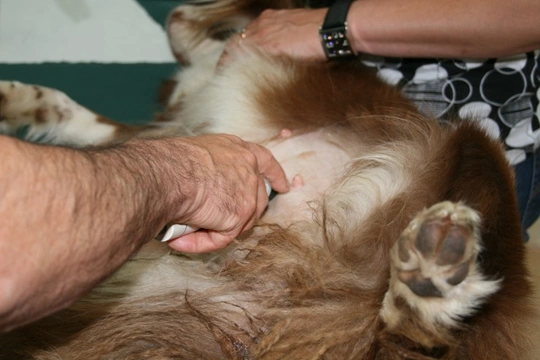
Dog Nipple Cysts: Causes, Symptoms & Treatment
Finding a lump, bump or strange mass on one (or more) of your dog’s nipples can be very alarming-but such growths do not necessarily or even normally indicate the presence of cancer. Dogs of either sex may develop relatively harmless non-cancerous or benign cysts on their mammary glands, and whilst these can be a problem-and it is very important to get your vet to examine them to rule out cancer-they are not the end of the world, and often, will have no impact on your dog at all.
Mammary gland cysts can theoretically affect any dog of either sex-but they are much more common in unspayed bitches than in either mal dogs or neutered females. This means that dog breeders and other owners whose bitches are unspayed should learn a little bit about mammary gland cysts, what they look like, and what they mean. Read on to learn more.
What are mammary gland cysts?
Mammary gland cysts are also sometimes known as benign tumours of the mammary glands, or fibrocystic growths. Whilst many people associate the word “tumour” with cancer, it is important to remember that this is not always the case-a malignant tumour is cancerous, but a benign tumour is not, and mammary gland cysts call into the latter category.
Mammary gland cysts develop within the mammary glands, above the milk ducts of the nipples or the areas above the nipples themselves, and may affect just one nipple or several all at once. What they look like can be very variable-some mammary gland cysts have a greyish or bluish tinge to them, while others may simply appear as slightly swollen individual nipples, or small bumps or nodules around the nipples.
In some cases, flesh-coloured lumps or masses can develop over or around the nipples themselves, and where any of these growths or swellings develop can be variable because the mammary glands are located above and behind the actual nipples, and not in the visible part of the nipple itself. It is these glands that are responsible for producing milk to feed a litter of young, and mammary gland cysts can of course affect a nursing dam’s ability to feed her litter.
The cysts that you can see and feel will usually be flexible and partially mobile rather than hard and fixed in place, which is one of the main ways in which they can be identified as distinct from malignant tumours.
The size and shape that they grow to can be very variable, from so small as to escape notice to large enough to occlude the nipple. Very large mammary cysts may run the risk of rupturing and weeping, which leads to the potential risk of infection developing.
What sort of dogs can they affect?
Mammary gland cysts can affect both male and female dogs, although they are much more common in females. Because the mammary glands are responsible for producing milk for pups, they are hormone-mediated, and so it is usually hormonal fluctuations or problems that cause mammary gland cysts. Unspayed bitches of reproductive age are more likely to develop mammary gland cysts than males or neutered females.
Why do dogs develop mammary gland cysts?
Unspayed bitches are much more likely to develop mammary gland cysts than neutered bitches, because neutering removes or greatly reduces the levels of sexual and reproductive hormones dogs produce, which in turn lessens the risk of anomalies or problems and in some cases, negates them altogether.
Mammary gland cysts can appear at any age, although they are more common in bitches of reproductive age, and their development may follow the dog’s hormone cycle of reproductive fertility.
This means that they might appear to develop very quickly at around the time that your dog goes into heat, and reduce in size or even disappear when her heat cycle ends.
Also, unspayed dogs that are given medications to supress or skip a heat cycle are also slightly more likely to develop mammary gland cysts than others, because these medications are in turn hormonal and so, have an effect on the body’s normal hormone production.
Can they be treated?
Mammary gland cysts are generally painless, harmless and don’t have any negative impacts upon your dog-she probably won’t even realise she has them, and for these reasons they are often simply left alone-and may disappear over time.
However, it is important to get your dog checked out if they develop what appear to be mammary gland cysts, in order to rule out a malignancy. Spaying your bitch if she is unspayed may also lead to the disappearance of the cysts, and/or prevent them recurring.
In some cases if the cysts are very large, obstructive or otherwise causing a problem-or if they are at risk of rupturing and increasing the risk of infection-your vet may recommend surgically removing them. There is also some evidence that removing the cysts can reduce the risk factors for the cysts becoming malignant in later life-which is a small risk, but one worth bearing in mind.



